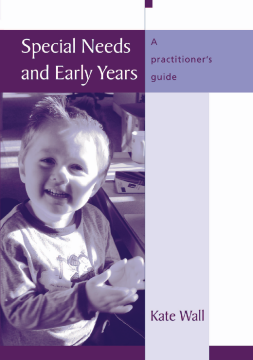
Additional Information
Book Details
Abstract
This is one of the best books I have read on special needs and the very young and I thoroughly recommend it to all with a professional or personal interest in this area' - Special Children 'This is an exemplary introductory textbook for students, and a veritable mine of information. Undoubtedly, this is an early years/special needs book that many readers can and will relate to' - Sheila Wolfendale, European Journal of Special Needs Education 'This well crafted -practitioners guide- thoughtfully addresses the many issues that practitioners face when they consider their involvement in early education in the context of work with special educational needs. Those who read this book will find that they know a little more about these important issues and may find themselves challenged to reflect on their personal attitudes towards inclusive education: ideally becoming better providers for children with learning difficulties'- Cathy Nutbrown, Journal of Early Childhood Research
Table of Contents
| Section Title | Page | Action | Price |
|---|---|---|---|
| ACKNOWLEDGEMENTS | |||
| ABBREVIATIONS | |||
| TABLES AND FIGURES | |||
| 1. Introduction | |||
| The farmer-led extension workshop | |||
| What is farmer-led extension? | |||
| Actors in farmer-led extension | |||
| The remainder of the book | |||
| 2. Challenges to agricultural extension in the twenty-first century | |||
| The changing global scene | |||
| The challenge to agriculture | |||
| Challenges for extension | |||
| 3. Extension experiences in agriculture and natural resource | |||
| management in the 1980s and 1990s | |||
| Introduction | |||
| Changing concepts and practice | |||
| Disenchantment with the public sector | |||
| Natural resource management and 'sustainability' | |||
| Issues | |||
| Looking ahead | |||
| 4. Origins and examples of farmer-to-farmer extension | |||
| Latin America | |||
| Indonesia | |||
| India | |||
| Philippines | |||
| Vietnam | |||
| 5. Principles and methods in farmer-to-farmer extension | |||
| Latin America | |||
| Indonesia | |||
| Philippines | |||
| Viemam | |||
| Nepal | |||
| Summary | |||
| 6. Roles and responsibilities in farmer-to-farmer extension | |||
| Farmer-extensionists | |||
| Extension workers and support agencies | |||
| 7. Issues and problems in farmer-to-farmer extension | |||
| Selection of farmer-extensionists | |||
| Payment and time allocation | |||
| Work location | |||
| Specialization | |||
| Gender issues | |||
| 8. Farmer field schools | |||
| Origins and principles | |||
| Methods and strategies | |||
| Role of professionals | |||
| Linking farmers | |||
| Links with research | |||
| Training of farmers and professionals | |||
| Selection of participants | |||
| Gender issues | |||
| 9. Problem censuslproblem solving | |||
| Nepal | |||
| Bangladesh | |||
| 10. NGO-government collaboration | |||
| Why are NGOs and government agencies willing to work together? | |||
| How do NGOs and government agencies work together? | |||
| Benefits fiom collaboration | |||
| Problems encountered in collaboration | |||
| Lessons learned fiom collaboration | |||
| 11. Other approaches to farmer-led extension | |||
| Supporting farmers' research | |||
| Limiting inputs to facilitation only | |||
| Helping farmers to access information | |||
| Combining institution-based training and farmer-led extension | |||
| Provision of fee-based service paid by farmers | |||
| 12. Impact assessment and evaluation | |||
| Individual or household-level assessment | |||
| Project-level assessment | |||
| Regional or national-level assessment | |||
| How to monitor, evaluate, and measure impact? | |||
| Indicators for assessing farmer-led extension | |||
| 13. Reaching more farmers | |||
| Scaling up | |||
| Scaling out | |||
| Constraints and positive influences | |||
| Environmental factors | |||
| Factors internal to the extension system | |||
| Factors internal to the community | |||
| Factors common to the extension system and the community . | |||
| 14. Lessons and conclusions | |||
| Categorizing the experiences | |||
| Prospects for expansion | |||
| Appendix 1: Workshop participants | |||
| Workshop organizers | |||
| Participants | |||
| Appendix 2: Papers cited and summarized | |||
| REFERENCES |
